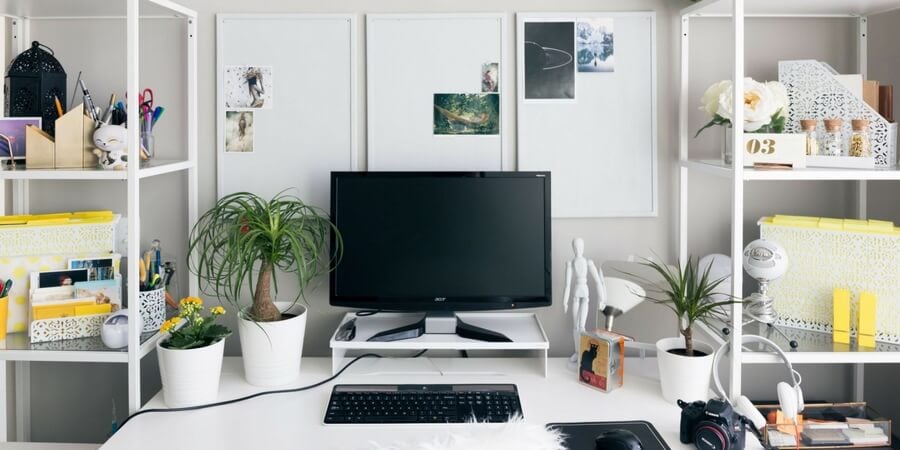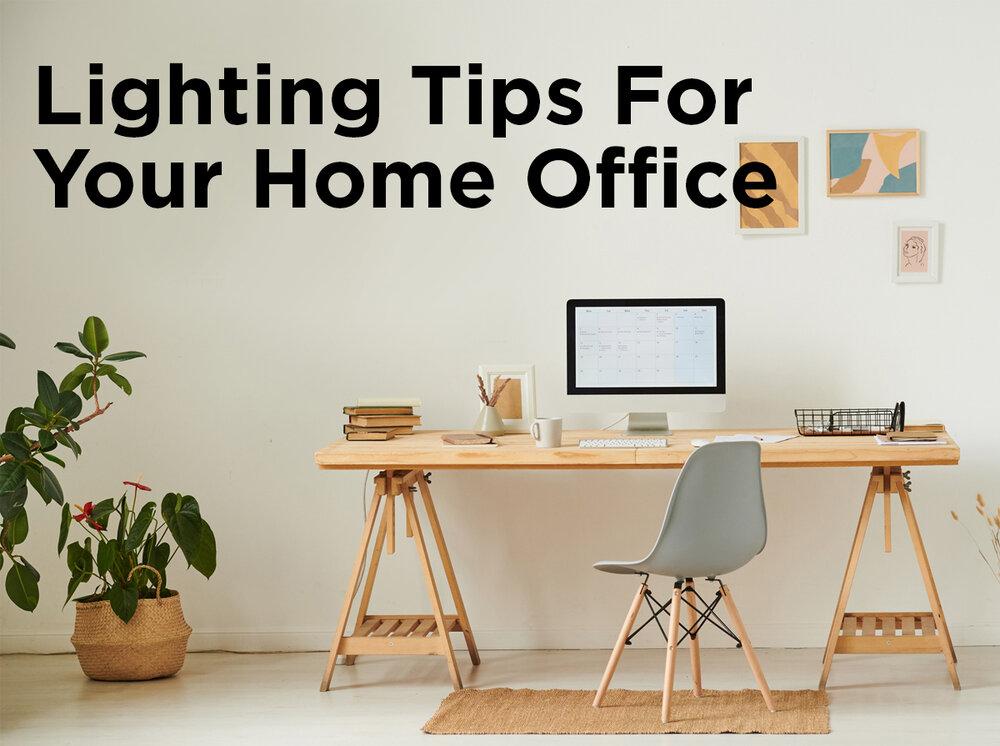When you work from home, having the right light is important. The best light for the home office is bright but not harsh, and it should be adjustable so you can control the amount of light you need. Natural light is always best, so if your home office has a window, make sure to take advantage of it.
If not, there are a few different types of artificial lighting that can give you the brightness you need without being too harsh on your eyes.
There are a few things to consider when choosing the best light for your home office. First, think about the type of work you’ll be doing in your office. If you’ll be spending most of your time working on the computer, then you’ll want a light that doesn’t cause glare on your screen.
A good desk lamp with an adjustable arm is a good option for this type of work. If you’ll be doing more paperwork or reading in your home office, then you might want a brighter light. An overhead fixture is a good choice for this type of work.
Make sure it’s not too bright, though, as that can also cause eye strain. Another thing to consider is the color temperature of the light. A cooler light (with a higher Kelvin rating) will help to keep you awake and alert, while a warmer light (with a lower Kelvin rating) will help to create a more relaxed atmosphere.
Finally, think about the style of your home office when choosing lighting. You want something that fits in with the overall look and feel of the space. Desk lamps and overhead fixtures are both great options for home offices.
Just make sure to choose one that matches your personal style!

Credit: www.thelightbulb.co.uk
What Color Light is Best for Home Office?
There is no definitive answer to this question as it depends on personal preferences and the type of work being done in the home office. However, some colors are known to be more conducive to concentration and productivity than others. Blue and green are often said to be the best colors for a home office, as they promote calm and focus.
Yellow can also be a good choice for a home office, as it is known to boost creativity and motivation. Ultimately, the best color for a home office will vary from person to person and it is worth experimenting with different shades to see what works best for you.
Is Led Light Good for Home Office?
Yes, LED light is good for home office because it is more energy efficient than traditional lighting. It also emits less heat, so it will not make your room feel as hot.
What Kind of Light is Best for a Desk?
There are a few things to consider when choosing the best light for your desk. The first is the type of lightbulb. LED bulbs are more energy-efficient and last longer than traditional incandescent bulbs, so they’re a good choice if you want to save money and reduce your environmental impact.
However, LED bulbs can emit a bluish light that can be harsh on the eyes, so if you’re looking for a softer light, an incandescent bulb may be a better option.
The second thing to consider is the intensity of the light. If you’re going to be spending long hours at your desk, you’ll want to make sure the light isn’t too bright or too dim.
You may also want to get a lamp with an adjustable neck so you can position the light exactly where you need it.
Finally, think about the style of lamp you want. There are many different options available, from simple task lamps to more ornate statement pieces.
Choose one that fits your personality and decorating scheme.
BEST Smart Lights for Transforming Your Office!
Best Lighting for Home Office
Are you looking for the best lighting for your home office? If so, you’ve come to the right place. In this blog post, we’ll go over some of the best options for lighting your home office, so that you can make the most productive space possible.
First, let’s talk about overhead lighting. Many people choose to use fluorescent bulbs in their overhead fixtures, as they provide bright, even light that is perfect for working under. However, some people find these bulbs to be too harsh, and they can cause headaches or eye strain.
If you fall into this category, consider using LED bulbs instead. LED bulbs emit a softer light that is easier on the eyes, and they are also more energy-efficient than traditional incandescent bulbs.
Next, let’s talk about task lighting.
This is the type of lighting that you use to illuminate your work surface when you’re focused on a specific task. For example, if you’re going to be working at your desk for long periods of time, it’s important to have a good task light so that you don’t strain your eyes. Many people choose to use clamp-on lamps for their task lighting needs; these lamps are easy to position exactly where you need them and they take up very little space on your desk.
Finally, let’s talk about ambient lighting. This is the type of lighting that sets the overall tone of your space and makes it feel warm and inviting. Ambient lighting can be provided by floor lamps, table lamps, or even string lights hung around the perimeter of your room.
Best Overhead Lighting for Home Office
There are many different types of overhead lighting that can be used in a home office. The best type of overhead lighting for a home office depends on the specific needs of the person using the space. Some people may need more light for task-oriented work, while others may prefer softer light for general use.
The first thing to consider when choosing overhead lighting for a home office is the type of bulb that will be used. LED bulbs are becoming increasingly popular because they are more energy efficient than traditional incandescent bulbs. They also last longer, so you won’t have to replace them as often.
If you choose an LED bulb, make sure it is dimmable so you can adjust the light level as needed.
Another consideration is the fixture itself. You want something that will provide even light distribution and not create glare on your computer screen or work surface.
A good option is a fluorescent fixture with a diffuser lens. This type of fixture emits little heat and doesn’t produce UV rays, making it safe to use near sensitive materials like photos or artwork.
Finally, think about how easy it will be to control the light level in your home office.
A simple switch by the door can turn on/off an overhead light, but if you want more control over the amount of light in the space, look for fixtures with multiple settings or invest in a dimmer switch. With some careful planning, you can create an optimal lighting environment for your home office that meets your specific needs and preferences!
Best Light Bulbs for Home Office
Are you looking for the best light bulbs for your home office? If so, you’ve come to the right place! In this blog post, we’ll discuss the different types of light bulbs and which ones are best suited for a home office.
There are three main types of light bulbs: incandescent, CFL (compact fluorescent), and LED (light-emitting diode). Incandescent bulbs are the most common type of bulb and can be found in most homes. They produce light by heating a filament inside the bulb.
CFLs are similar to incandescents, but they use less energy and last longer. LEDs are the most energy-efficient type of bulb and can last up to 25 years!
So, which type of light bulb is best for a home office?
That depends on your needs and preferences. If you want a bright light that will help you focus on work, an LED is your best bet. If you’re looking to save money on your energy bill, go with a CFL.
And if you’re looking for a traditional light bulb that’s easy to find, go with an incandescent.
Best Home Office Lighting for Eyes
If you work from home, then you know how important it is to have a good lighting setup in your home office. The right lighting can help improve your productivity and focus, while the wrong lighting can lead to eye strain and headaches. So what’s the best home office lighting for eyes?
Here are a few tips to help you create a healthy and productive workspace: 1. Avoid glare. Glare from your computer screen or window can cause eye fatigue.
To reduce glare, use blinds or curtains to cover windows, and adjust your computer screen’s brightness and contrast settings. If you wear glasses, make sure they have an anti-glare coating. 2. Use task lighting.
In addition to general room lighting, use a desk lamp or other task light to illuminate your work area. This will help reduce eye strain and allow you to see more clearly. Position the light so that it’s not shining directly into your eyes.
3 . Take breaks often. Every 20 minutes or so, get up from your desk and walk around for a few minutes.
This gives your eyes a break from looking at screens all day long. And while you’re up, take advantage of natural light by opening blinds or curtains. 4 Get an annual comprehensive dilated eye exam.
Many vision problems have no obvious symptoms, so it’s important to get regular checkups. Be sure to tell your doctor if you spend significant time working on a computer screen; he or she may recommend special eyewear designed for computer users.
Conclusion
In an office, light is important for both productivity and comfort. The best light for a home office depends on the type of work you do and the amount of natural light in the room. If you have a lot of natural light, you can get by with task lighting.
If you don’t have much natural light, you’ll need to use a combination of general and task lighting. General lighting should be bright enough to illuminate the entire room, while task lighting should be focused on your work area.
If you work from home, then you know how important it is to have a well-lit workspace.
The right kind of lighting can make all the difference in terms of productivity and comfort. But what is the best light for a home office?
It depends on several factors, including the type of work you do and the amount of natural light in the room.
If you have a lot of natural light coming in through windows, then you can probably get by with just using task lighting. This means having a lamp or two that provides direct illumination on your desk or work surface.
On the other hand, if you don’t have much natural light in your home office, then you’ll need to use a combination of general and task lighting.
General lighting should be bright enough to illuminate the entire room so that there are no dark corners or areas. This can be achieved with overhead fluorescent lights or even track lights mounted on the ceiling. Task lighting, as we mentioned before, should be focused on your work area specifically – such as under-cabinet lights that shine directly onto your desk top surface.
So there’s no one-size-fits-all answer when it comes to finding the best light for your home office space; it really depends on your individual needs and set up!

